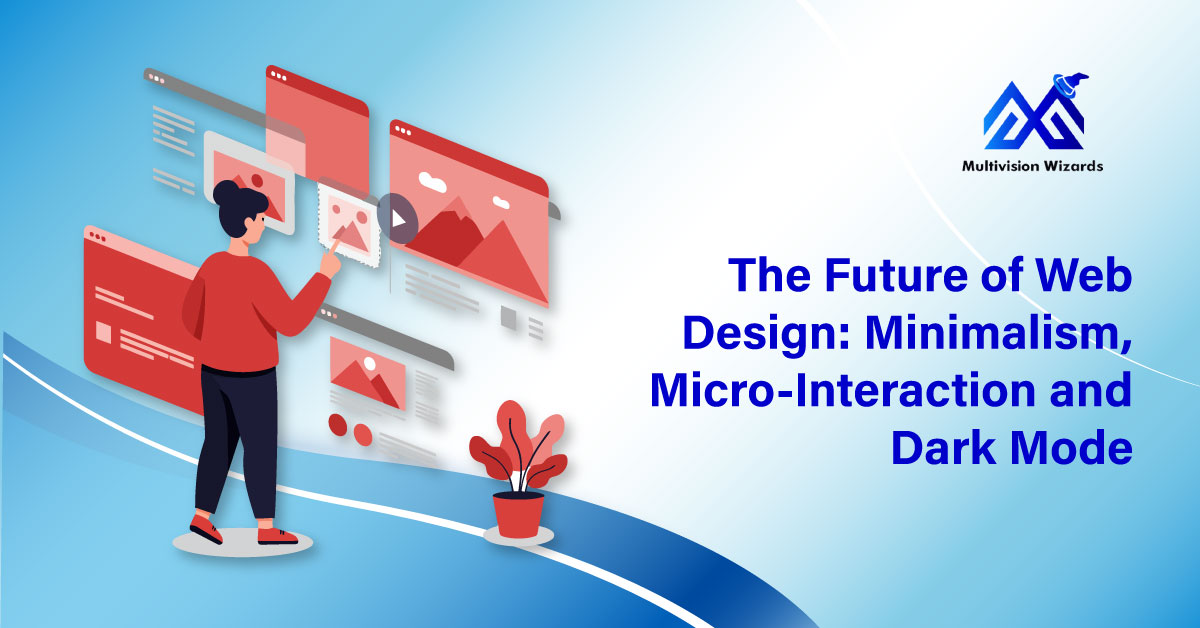The Future of Web Design: Minimalism, Micro-Interaction and Dark Mode
In today’s digital era every brand is incomplete without a website because more than you the client only trusts that specific brand who is having website advancement. A website is far more than a simple presence. It serves as the foundation of your brand identity, your company’s online store and frequently starting towards clients contact.
As we know perceptions really matter whenever we look into anything because your audience will only get influenced by your appearance, feel, and functionality of your brand’s website. A poor website creates negative results and losses in business but a creative website.

The design of websites has always been evolving, new trends come up every year with new ideas, new creativity and implementations. Some of them go away quickly whereas the others change how companies interact with their target market.
There are three fundamental concepts which are minimalism, micro-interaction and dark mode that are creating the groundwork for the future.
Defining Minimalism: The Power Of Simplicity
When we use minimalism this specific term defines a philosophy of less is more that removes unnecessary and functional websites. This term has long been popular in terms of design. It basically prioritises performance, purpose and clarity. It puts the user’s journey first rather than drawing them with too many images, components or messages.
A minimalist website always refers to being less but creative without mess. It can be compared to coming into a contemporary, structured office. Your attention naturally shifts towards main and essential concepts and space is welcoming the well-designed and well creative. If you were in a public chaotic place with lots of distractions and you probably would want to escape, the same thing happened with the internet where the thousands plus options are available with different concepts.
The reason behind the essentiality of minimalism are as following:
- Makes Navigation Easier: People can find what they’re looking for in straightforward concepts.
- Enhances Load Time: Lighter and faster websites load fast without chaos which improves SEO.
- Improves Readability: Users can focus on the content and details easily with concentration when there is clear typography and white space.
- Develop Trust: Professionalism shown when website layout is clean and in formatted layout.
Minimalism is not only effective to design a website but to improve the capability of the SEO perspective. Google gives preference to websites that are faster and easy to use.
A very simple quick design lets users and search engines know that your company values clarity and efficiency.
Minimalism is a communication strategy for companies as much as a design decision. By emphasizing the important or valuable points that you provided to your audience with the information that they require without any interruptions.
Micro-Interactions: The Human Touch in Digital Experiences
Micro-interactions provide websites personality and functionality, whereas minimalism aims to reduce distractions. These are the basic design elements that react to user-actions, such as a shopping cart icon that animates when an item is added and a button that changes the color and starts blinking which represents something is added to it or a form that displays real-time validation.
These components might not seem like much on their own but when merged they drastically alter user’s experiences. Micro-interaction serves as a digital body language, confirming actions, guiding users through the whole process by adding the human touch to the website.
The main essential reasons that why they matters are as followed:
- User guidance: Micro-interactions reduce confusion by offering instant feedback.
- Emotional connection: They create delight and keep users engaged longer.
- Brand personality: This helps to modify animations which can reflect the tone and the style of the company.
- Improved conversions: People are more likely to do things like buy things or fill out forms if the interaction is seamless and easy to understand.
Consider e-commerce as a case in point. When a consumer clicks "add to cart" and the cart icon quietly bounces or refreshes in real time, it reassures them that their action was successful. These little signals instill trust, diminish frustration, and enhance overall satisfaction.
In a competitive online environment, micro-interactions are what make a forgettable website stand out from one that's memorable. They are evidence that the business cares about details and respects the user experience.
Dark Mode: Modern, Comfortable and Functional
Dark mode is now a common user expectation rather than just a design fad. With good reason, it is now a feature of an increasing number of websites, operating systems, and apps.
Dark mode reverses the conventional colour scheme, substituting light text and dark hues for bright backgrounds. Particularly for users who spend a lot of time in front of screens, it is sleek, contemporary, and easier on the eyes.
These are the main advantages:
- Reduces eye strain: Particularly helpful in low-light environments.
- Saves battery life: Especially on OLED and AMOLED screens.
- Enhances focus: Content often stands out more against darker backgrounds.
- Offers user control: Allowing visitors to toggle between light and dark modes improves personalization.
For companies, dark mode implementation is an expression of how much you pay attention to user comfort. It is a minor but significant gesture toward building a website responsive to user requirements. In those sectors where professionalism and trendy charm are important—such as tech, banking, and design services—dark mode also gives you a cutting-edge, advanced feel.
How These Trends Interact
Minimalism, micro-interactions, and dark mode are distinct trends, but in reality, they work best together. Minimalism sets the base with a lean, quick, and easy-to-use composition. Micro-interactions animate that composition, leading users with subtle feedback. Dark mode customizes the experience, providing users with control and comfort.
The future of web design is less about doing more and more, and more about perfecting experiences. Combined, these three trends produce websites that find equilibrium between functionality and beauty, simplicity and stimulation, and performance and personalization.
Where Businesses See the Real Benefits
- Startups and small businesses: Simple design conveys professionalism and direction, assisting young businesses in establishing credibility in a hurry.
- E-commerce sites: Micro-interactions enhance shopping experiences, minimizing cart abandonment, and optimizing conversions.
- Service-based industries: Providing dark mode indicates care towards client comfort and evokes a contemporary, refined ambiance.
- Corporate brands: Together, all three trends illustrate innovation and positions companies as progressive industry leaders.
Regardless of what your business does, these design strategies enhance the user experience and the business result. A website developed on these foundations not only appears up to date but also functions at a standard that is acceptable in today's world.
Human-Centered Design: The Real Future of Web Design
At its essence, web design isn't about trends—it's about human problem-solving. Whenever someone arrives at a website, they do so with an agenda: to learn, to purchase, to engage. User-centric design trends are the ones that last. Minimalism unblocks. Micro-interactions lead and comfort. Dark mode provides option and ease. Combined, they're building a future where websites aren't just virtual places but human experiences.
For companies, adopting these principles is about more than staying competitive. It's about demonstrating to customers that you get them, value their time, and care about the way they interact with your brand.
Conclusion: Partner with Multivision Wizards for Future-Ready Web Design
The future of web design is simple yet powerful. By embracing minimalism, micro-interactions, and dark mode, businesses can build websites that are faster, smarter, and more engaging. These trends go beyond appearances—they directly influence trust, satisfaction, and long-term loyalty.
At Multivision Wizards, we specialize in creating websites that merge design with strategy. Our team understands the balance between aesthetics and performance, ensuring every project we deliver is not only visually striking but also optimized for results.
Whether you are a startup aiming for clarity, an e-commerce store seeking seamless interactions, or a brand looking to modernize with dark mode, we bring the expertise to make it happen.


